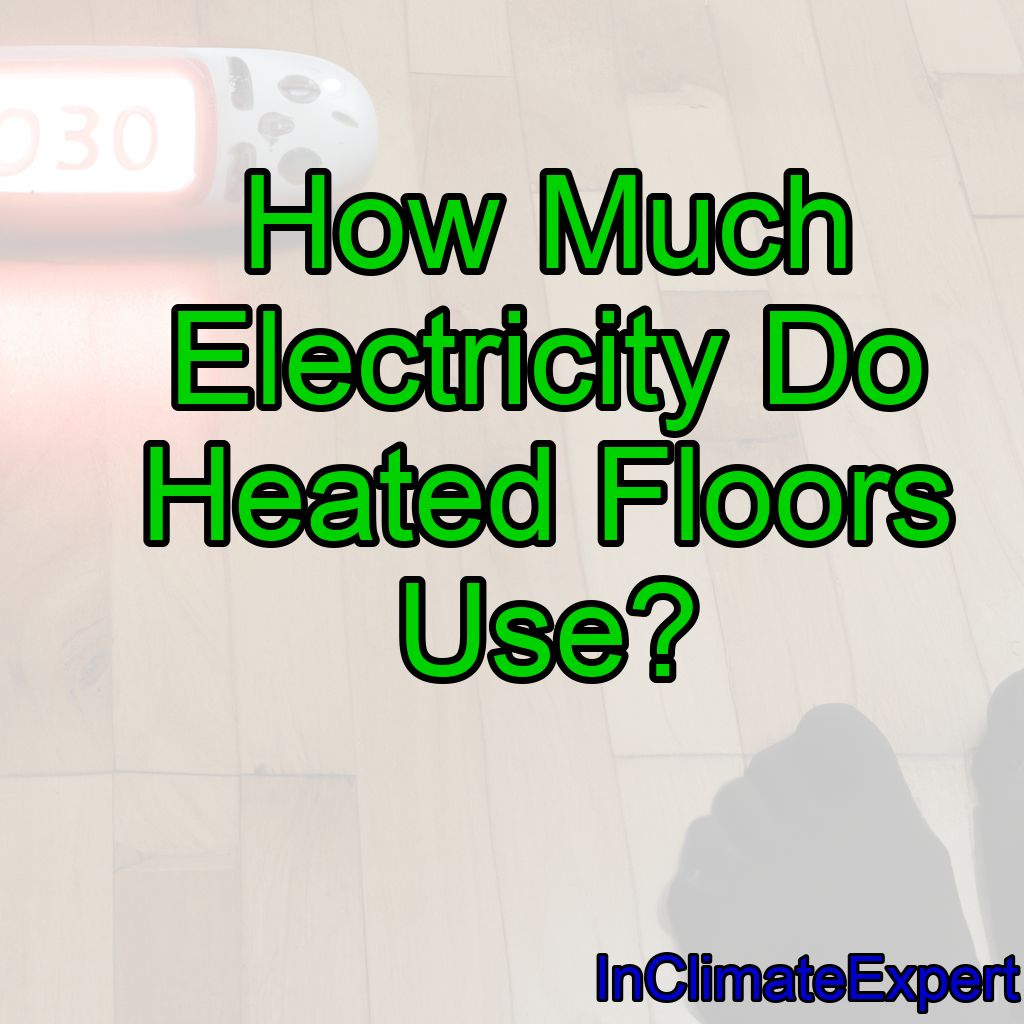Have you ever considered heating your floors? It may sound like a luxurious and unnecessary expense, but it can actually save you money in the long run. Not to mention, it adds an element of comfort that traditional heating methods simply cannot provide.
Heated floors use approximately 8-15 watts per square foot of electricity.
However, before taking the plunge into heated floors, it’s important to consider the cost of electricity. How much electricity do heated floors use? Let’s take a closer look.
For those who crave innovation and want to stay ahead of the curve, heated floors are an intriguing option. They offer a modern and efficient way to warm up your home while providing a unique touch of luxury. But with great innovation comes great responsibility – or rather, great costs.
Understanding how much energy is needed to power these systems is crucial for anyone considering this upgrade. So let’s dive in and explore the ins and outs of electricity usage when it comes to heated floors.
Benefits Of Heated Floors
Are you tired of walking on cold floors during the winter months? Heated floors may be just what you need to make your home more comfortable. Not only do they provide warmth, but they also offer several benefits.
Firstly, heated floors are energy-efficient and cost-effective. They can help reduce your heating bills by supplementing your existing heating system, which means you won’t have to rely solely on your HVAC system to keep your home warm.
Additionally, heated floors are quiet and unobtrusive, unlike traditional radiators or baseboard heaters. They also distribute heat evenly throughout a room, eliminating hot and cold spots.
Now that we’ve established the numerous benefits of heated floors, let’s talk about how much electricity they use.
Calculating Electricity Usage
Let’s talk about estimating heated floor electricity use and average costs of heated floors. We’ll break down how much electricity they consume and what they might cost.
Estimating Heated Floor Electricity Use
Have you ever wondered how much electricity your heated floors use? It’s a common question for those who want to stay warm in the winter months without breaking the bank.
Estimating heated floor electricity use can be tricky because it depends on several factors, including the size of the room, the type of flooring material, and the thermostat settings. However, there are some general guidelines that can help you estimate your usage.
For example, electric radiant heating systems typically use around 10-15 watts per square foot of floor space. So if you have a 200 square foot room with heated floors, you can expect to use between 2,000 and 3,000 watts of electricity per hour when they’re turned on.
Keep in mind that this is just an estimate and your actual usage may vary based on your specific situation. But by understanding these basic principles, you can make informed decisions about how to heat your home efficiently and effectively without sacrificing comfort.
Average Costs Of Heated Floors
Now that we’ve covered how to estimate the electricity usage of heated floors, let’s shift our focus to the cost.
The average cost of installing radiant heating systems can vary depending on several factors, such as the type of flooring material, size of the room, and labor costs.
On average, homeowners can expect to pay between $10 and $20 per square foot for electric radiant heating installations.
While this may seem expensive compared to other heating options, it’s important to consider the long-term benefits that heated floors provide, such as energy efficiency and increased home value.
So if you’re looking for an innovative way to keep your home warm and cozy during the winter months, heated floors may be worth considering.
Types Of Heated Floors
Let’s start by discussing electric floor heating. We’ll go over how much electricity it uses and what kind of maintenance is needed. Then we’ll look at in-floor hydronic systems and how they compare to electric floor heating.
Electric Floor Heating
If you’re considering heated floors for your home, electric floor heating is a popular option to consider.
This type of heated flooring uses electricity to heat up thin mats or cables installed beneath your flooring material.
While the initial installation cost may be higher than other types of heated flooring, electric floor heating is generally more energy-efficient and easier to control with individual thermostats for each room.
It’s also worth noting that the amount of electricity used by electric floor heating varies depending on the size of the space being heated and how frequently it’s used.
However, in general, electric floor heating systems are designed to use less electricity than traditional forced-air heating systems, making them a smart choice for both the environment and your wallet.
In-Floor Hydronic Systems
Now, let’s talk about another type of heated flooring: in-floor hydronic systems.
Unlike electric floor heating, which uses electricity to warm thin mats or cables beneath your floors, in-floor hydronic systems use heated water or a mixture of water and antifreeze to create warmth.
This system involves installing pipes beneath the flooring material, through which hot water flows to provide radiant heat.
While the upfront cost for installation may be higher for in-floor hydronic systems than other types of heated flooring, they are known for being highly energy-efficient and can provide even heat distribution throughout your home.
Plus, with advances in technology, these systems can now be controlled using smart thermostats and mobile apps for optimal temperature regulation.
So if you’re looking for an innovative way to keep your home warm and cozy during those cold winter months, consider exploring in-floor hydronic systems as a viable option.
Cost Of Installing Heated Floors
Now that we have explored the different types of heated floors, let’s take a closer look at the cost of installation.
While the upfront investment may seem high, it is important to consider the long-term benefits and savings.
The cost of installing heated floors varies depending on factors such as the size of the room and type of flooring material.
On average, the cost for installation can range from $10 to $20 per square foot.
However, this cost can easily be offset by the energy savings in the long run.
Heated floors use less electricity than traditional heating systems because they directly heat objects and people, rather than just heating air.
This means that you can save up to 15% on your energy bill each year with heated floors.
Overall, investing in heated floors not only provides comfort and luxury in your home but also saves you money in the long run without sacrificing energy efficiency.
By choosing to install heated floors, you are making a conscious decision towards modern innovation in home design while being mindful of your impact on the environment.
So why settle for traditional heating systems when you can enjoy a more comfortable and energy-efficient lifestyle with heated floors?
Conclusion
In conclusion, heated floors are a great addition to any home, providing warmth and comfort during the colder months. The benefits of heated floors go beyond just keeping your feet warm, as they can reduce heating costs and improve indoor air quality by eliminating the need for forced-air heating systems.
When it comes to calculating electricity usage, it’s important to consider the type of heated floor you have installed. Electric radiant floor heating systems can use anywhere from 10 to 20 watts per square foot depending on the temperature setting and insulation. However, hydronic radiant floor heating systems use less energy because they rely on hot water that is heated by a boiler or solar panels.
The cost of installing heated floors varies depending on the type of system you choose and the size of your home. While electric radiant floor heating systems are easier and cheaper to install compared to hydronic systems, they have higher operating costs.
Ultimately, investing in heated floors can improve your home’s value and provide long-term savings on energy bills while keeping your home cozy all winter long!




